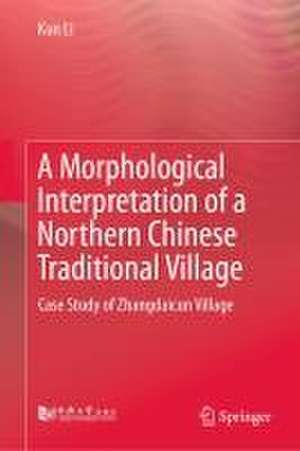A Morphological Interpretation of a Northern Chinese Traditional Village: Case Study of Zhangdaicun Village
Autor Kun Lien Limba Engleză Hardback – 24 apr 2024
Preț: 739.31 lei
Preț vechi: 901.59 lei
-18% Nou
Puncte Express: 1109
Preț estimativ în valută:
141.47€ • 145.95$ • 118.06£
141.47€ • 145.95$ • 118.06£
Carte disponibilă
Livrare economică 05-19 martie
Preluare comenzi: 021 569.72.76
Specificații
ISBN-13: 9789819969609
ISBN-10: 9819969603
Pagini: 323
Ilustrații: LI, 323 p. 223 illus., 177 illus. in color.
Dimensiuni: 155 x 235 mm
Greutate: 0.78 kg
Ediția:2024
Editura: Springer Nature Singapore
Colecția Springer
Locul publicării:Singapore, Singapore
ISBN-10: 9819969603
Pagini: 323
Ilustrații: LI, 323 p. 223 illus., 177 illus. in color.
Dimensiuni: 155 x 235 mm
Greutate: 0.78 kg
Ediția:2024
Editura: Springer Nature Singapore
Colecția Springer
Locul publicării:Singapore, Singapore
Cuprins
.-Introduction.- Traditional rural heritage conservation in China: policies and theories.- Theoretical basis of the investigation and rural landscape in Hancheng.- Morphological investigation: Zhangdaicun Village's case study.- The four elements of rural settlement form.- Safeguarding the integrity of the village form.- Conclusions and Prospects.
Notă biografică
Li Kun is an associate professor of Architecture at Xi'an University of Architecture and Technology, a researcher at the State Key Laboratory of Green Building (China), and also the deputy secretary-general of the Professional Committee of Residential Buildings of ASC( the Architectural Society of China) as well as the vice-director of the Shaanxi Provincial Rural Revitalisation Planning and Research Institute. He received his B.Arch and M.Arch from Xi'an University of Architecture and Technology in 2009 and 2012, respectively, and his PhD in Architecture, Built Environment and Construction Engineering from Politecnico di Milano in 2021.
Textul de pe ultima copertă
This book challenges the definition of a new approach for integrating protection and enhancing the Chinese heritage category of “Traditional Villages”. By applying a specific case study in the Hancheng context, Shaanxi Province, which lacks sound studies, the book formulates new theoretical prerequisites for future re-searches, an in-depth knowledge path, and sound methodological principles. By working in a multiple scales approach, the object of preservation and enhancement is first of all redefined in its ontology as a unity formed by the courtyard type, the morphology of the village, and the related landscape structures. All these three levels of study have been deeply investigated, put into the relationship and resulting in a new methodology which overcomes the inadequacy and ineffectiveness of the notion of “setting” deriving from conservation Charters, to embrace the structural notion of “context” and a knowledge approach to rural settlements’ form. The innovative and original features of this book are both in the reading villages in their landscape dimension, which in turn is studied as a context made of several interrelated structures. Another original feature of the book is the integration of Italian historic-structural and morphological methodologies with specific Chinese cultural aspects. The author’s work dug deeply and interdisciplinary in all those dimensions to account for the complex issues that are related and embodied in both the physical and intangible meaning of human settlements, opening a novel scientific methodology for Chinese studies as a sound base to define three key integrated project actions: what, why, how to preserve, enhance, develop.
Caracteristici
Deals with the integration of Italian historic-structural and morphological methodologies Provides first comprehensive discussion and positive interpretation of reasons for unique "structural-material" forms Develops an explanatory approach to the dynamics of traditional Chinese settlement formation mechanisms
